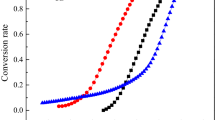Abstract
Load-following operations of coal power plants are required to cope with the variability in power generation from renewable energy sources. This study aimed to optimize combustion in coal-fired power plants at low loads by analyzing combustion efficiency, NOx emissions, and ash deposition in a boiler. An experiment was conducted by varying the heat input in a bench-scale combustion system. The combustion performance, in terms of the CO concentration in combustion gas and unburned carbon content in ash, degraded during low-load operation. Consequently, the fuel ratio was found to be a key factor for determining the combustion efficiency during low-load operation. The nitrogen content of the fuel was dominant in terms of the NO conversion ratio. The inconsistency in the ash deposition tendency suggested that it was affected more by the composition of minerals than by the amount of ash or total feed rate of ash in coal.
Similar content being viewed by others
References
I. B. Golovanov, D. A. Tikhonov and I. G. Tsygankova, The RISM method for estimating hydrophobic intramolecular interactions between distant groups, Russ. J. Phys. Chem. A, 74(5) (2000) 763–766.
S. R. Sinsel, R. L. Riemke and V. H. Hoffmann, Challenges and solution technologies for the integration of variable renewable energy sources—a review, Renew. Energy, 145 (2020) 2271–2285.
M. Fiebrandt, J. Röder and H.-J. Wagner, Minimum loads of coal-fired power plants and the potential suitability for energy storage using the example of Germany, Int. J. Energy Res., 46(4) (2022) 4975–4993.
C. Na et al., The flexible operation of coal power and its renewable integration potential in China, Sustainability, 11(16) (2019) 4424.
H. Lens, Mid-Load Operation of Large Coal-Fired Power Plants, STEAG Energy Services GmbH, Germany(2014).
J. Kim, Flexible operation technology of thermal power plant The Korean Institute of Electrical Engineers, 69(6) (2020) 4–10.
W. Kim and H.-H. Jo, Impact of solar power generation expansion on Korea’s electric power system and countermeasures: focusing on grid and supply-demand stability, The Korean Journal of Economics, 27 (1) (2020).
J. Ahn, A Study on the Reinforcement of Power System Flexibility in Preparation for the Spread of New and Renewable Energy, Korea Energy Economics Institute, Korea (2017).
International Energy Agency, Status of Power System Transformation 2018: Advanced Power Plant Flexibility, IEA, Paris (2018).
J. Hentschel, U. Babic and H. Spliethoff, A parametric approach for the valuation of power plant flexibility options, Energy Rep., 2 (2016) 40–47.
E. Sanchez Fernandez et al., Operational flexibility options in power plants with integrated post-combustion capture, Int. J. Greenh. Gas Control, 48 (2016) 275–289.
Y. Zheng, X. Gao and C. Sheng, Impact of co-firing lean coal on NOx emission of a large-scale pulverized coal-fired utility boiler during partial load operation, Korean J. Chem. Eng., 34(4) (2017) 1273–1280.
Y. Zhao et al., Fatigue lifetime assessment on a high-pressure heater in supercritical coal-fired power plants during transient processes of operational flexibility regulation, Appl. Therm. Eng., 156 (2019) 196–208.
Y. Sun et al., A comprehensive analysis of a thermal energy storage concept based on low-rank coal pre-drying for reducing the minimum load of coal-fired power plants, Appl. Therm. Eng., 156 (2019) 77–90.
A. S. Brouwer et al., Operational flexibility and economics of power plants in future low-carbon power systems, Appl. Energy, 156 (2015) 107–128.
I. Avagianos et al., Predictive method for low load off-design operation of a lignite fired power plant, Fuel, 209 (2017) 685–693.
X. Han et al., Thermodynamic analysis and life cycle assessment of supercritical pulverized coal-fired power plant integrated with No.0 feedwater pre-heater under partial loads, J. Clean. Prod., 233 (2019) 1106–1122.
J. C. Eslick et al., Predictive modeling of a subcritical pulverized-coal power plant for optimization: parameter estimation, validation, and application, Appl. Energy, 319 (2022) 119226.
H. Wei et al., Flexible operation mode of coal-fired power unit coupling with heat storage of extracted reheat steam, J. Therm. Sci., 31(2) (2022) 436–447.
E. Vainio et al., Understanding low-temperature corrosion in recovery boilers: risk of sulphuric acid dew point corrosion, Journal of Science & Technology for Forest Products and Processes, 4(6) (2014) 14–22.
B. W. Butler and B. W. Webb, Measurement of radiant heat flux and local particle and gas temperatures in a pulverized coal-fired utility-scale boiler, Energy Fuels, 7(6) (1993) 835–841.
Z. Li et al., Experimental study and mechanism analysis on low temperature corrosion of coal fired boiler heating surface, Appl. Therm. Eng., 80 (2015) 355–361.
M. A. Gonzalez-Salazar, T. Kirsten and L. Prchlik, Review of the operational flexibility and emissions of gas- and coal-fired power plants in a future with growing renewables, Renew. Sustain. Energy Rev., 82 (2018) 1497–1513.
P. P. Ptaza, The development of a slagging and fouling predictive methodology for large scale pulverised boilers fired with coal/biomass blends, Ph.D. Thesis, Cardiff University, UK (2013) 227.
T. Tsumura et al., Reducing the minimum load and NOx emissions for lignite-fired boiler by applying a stable-flame concept, Appl. Energy, 74(3–4) (2003) 415–424.
J. M. Beer and N. A. Chigier, Combustion aerodynamics, Int. J. Heat Mass Transf., 16(2) (1973) 528.
Acknowledgments
This work is part of the “Development of boiler combustion and environmental facility optimization technology for flexible operation project (R20GA10)” supported by the Korea Electric Power Corporation (KEPCO).
Author information
Authors and Affiliations
Corresponding authors
Additional information
Hyunggeun Kwak is a M.S. student of the Mechanical Engineering, Yonsei University, Seoul, Korea. His research interests include combustion, heat transfer.
Rights and permissions
About this article
Cite this article
Kwak, H., Lee, J., Lee, Y. et al. Characteristics of combustion and ash deposition for pulverized coal combustion under various thermal loads: An experimental study in an 80 kWth combustion system. J Mech Sci Technol 38, 979–987 (2024). https://doi.org/10.1007/s12206-024-0142-9
Received:
Revised:
Accepted:
Published:
Issue Date:
DOI: https://doi.org/10.1007/s12206-024-0142-9




